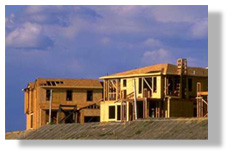

Loan forms may be obtained from participating enders or the Energy Office, or the agency's web site by clicking here.
As of June 30, 2003: 20,608 loans for $176.9 million
A:
There are no provisions in federal or state tax codes which allows a taxpayer to claim interest paid on a Dollar and Energy Saving Loan as a deduction on a return.
However, the interest may be deductible depending on how the Dollar and Energy Saving Loan is secured by the lender, e.g. by the borrower's home, or type of borrower or operation, such as business or agriculture. Borrowers should check with their tax accountant, the Internal Revenue Service, or the Nebraska Department of Revenue, to make a determination as to whether the interest paid on a Dollar and Energy Saving Loan is deductible.

A:
The Energy Office no longer provides incentive funding for reduced rate mortgages.
The Energy Office's Dollar and Energy Saving Loans are available for low interest loans for energy efficiency improvements and specific waste minimization projects in existing homes, dwelling units, businesses, agricultural operations and local governments, excluding public school districts. Construction of new homes, which substantially exceed current national energy codes and incorporate a number of green building techniques, are being promoted through the Nebraska Green Building Council. This Council certifies the homes which qualify under their guidelines as a Nebraska Certified Green Built Home. The council also certifies home builders who meet the required criteria as Nebraska Certified Green Builders.
A:
You may contact the Energy Office loan staff directly for names of lenders in your area who offer Dollar and Energy Saving loans. Inquiries for participating lenders may be directed to John Osterman.
However, keep in mind that whether you are a new customer or an existing customer of a participating lender, when you apply for a Dollar and Energy Saving Loan you must meet their credit underwriting requirements in addition to meeting the Nebraska Energy Office's eligibility requirements for residency and improvements. A participating lender must also follow Energy Office guidelines on term, rate, loan amount, and fees on the Dollar and Energy Saving Loans. Lenders are responsible for determining the creditworthiness of a borrower and whether the borrower meets the requirements of their particular loan policies, which will vary from lender to lender.
A:
There is a difference between the maximum rate of interest which a lender can charge on a Dollar and Energy Saving Loan, currently 5 percent, and the Annual Percentage Rate, or A.P.R., which is disclosed on the loan.
The rate a lender uses to compute interest on the principal you borrow for a Dollar and Energy Saving Loan is 5 percent, or less, if the lender offers a lower rate of interest on the loans. If the lender charges you no loan fees which federal regulations deem to be "finance charges," then the A.P.R. is the same as the interest rate. However, if a lender charges certain fees which are deemed "finance charges" such as an application or origination fees, then these charges are added into the interest you will be paying over the term of your loan to arrive at an A.P.R. which takes both into account. Thus, "finance charges," if paid at the time of the loan, result in the A.P.R disclosed for your loan being higher than the interest charge on the loan.
The loan document will state an interest rate, say 5 percent, but the A.P.R. appearing on the loan contract will show a higher percentage if finance charges are factored in with the interest to be paid.
The Energy Office recommends borrowers check with lenders as to what their A.P.R. is on the Dollar and Energy Saving Loans they make and whether disclosure of an A.P.R. is required for the type of loan being sought. The Energy Office does limit the dollar amount of indirect loan fees a lender may charge on a Dollar and Energy Saving Loan to make sure that the low rate of interest offered on the loans is not negated by other finance charges.